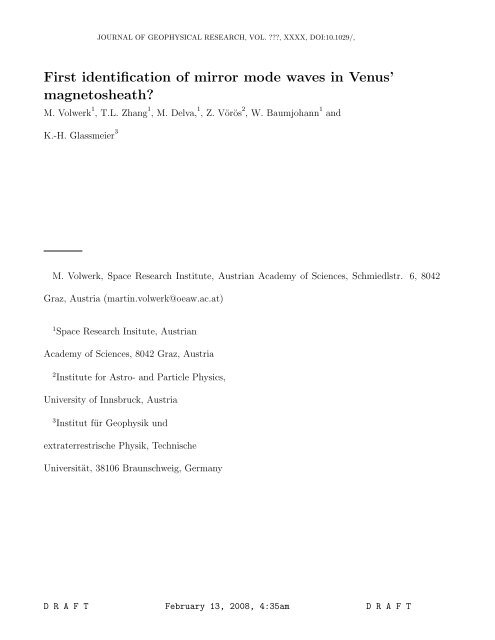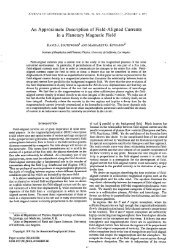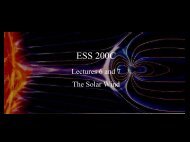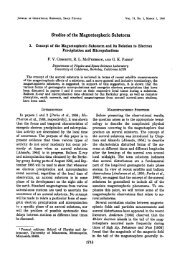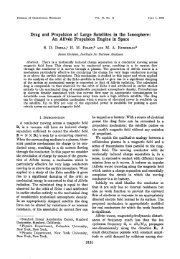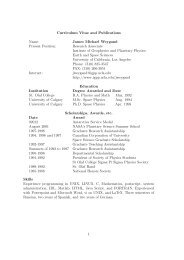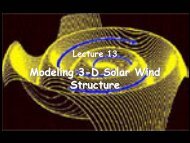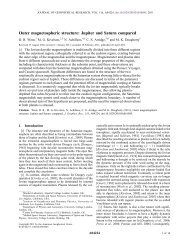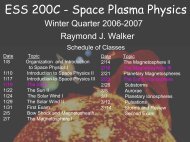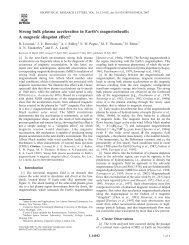First identification of mirror mode waves in Venus' magnetosheath?
First identification of mirror mode waves in Venus' magnetosheath?
First identification of mirror mode waves in Venus' magnetosheath?
You also want an ePaper? Increase the reach of your titles
YUMPU automatically turns print PDFs into web optimized ePapers that Google loves.
JOURNAL OF GEOPHYSICAL RESEARCH, VOL. ???, XXXX, DOI:10.1029/,<strong>First</strong> <strong>identification</strong> <strong>of</strong> <strong>mirror</strong> <strong>mode</strong> <strong>waves</strong> <strong>in</strong> Venus’<strong>magnetosheath</strong>?M. Volwerk 1 , T.L. Zhang 1 , M. Delva, 1 , Z. Vörös 2 , W. Baumjohann 1 andK.-H. Glassmeier 3M. Volwerk, Space Research Institute, Austrian Academy <strong>of</strong> Sciences, Schmiedlstr. 6, 8042Graz, Austria (mart<strong>in</strong>.volwerk@oeaw.ac.at)1 Space Research Insitute, AustrianAcademy <strong>of</strong> Sciences, 8042 Graz, Austria2 Institute for Astro- and Particle Physics,University <strong>of</strong> Innsbruck, Austria3 Institut für Geophysik undextraterrestrische Physik, TechnischeUniversität, 38106 Braunschweig, GermanyD R A F T February 13, 2008, 4:35am D R A F T
X - 2Abstract.VOLWERK ET AL.: VENUS’ MIRROR MODE WAVESMagnetometer data from the Venus Express spacecraft obta<strong>in</strong>ed<strong>in</strong> Venus’ <strong>magnetosheath</strong> are <strong>in</strong>vestigated, to search for evidence for the existence<strong>of</strong> <strong>mirror</strong>-<strong>mode</strong> <strong>waves</strong>. In two regions <strong>in</strong> the Venusian <strong>magnetosheath</strong>strong compressional, <strong>waves</strong> which propagate nearly perpendicular to the ambientmagnetic field, have been found. They are most likely <strong>mirror</strong>-<strong>mode</strong> <strong>waves</strong>.These <strong>waves</strong> show up just beh<strong>in</strong>d the quasi-perpendicular bow shock, andnear the magnetopause dur<strong>in</strong>g compression <strong>of</strong> the <strong>magnetosheath</strong> due to <strong>in</strong>creasedsolar w<strong>in</strong>d pressure.D R A F T February 13, 2008, 4:35am D R A F T
VOLWERK ET AL.: VENUS’ MIRROR MODE WAVES X - 31. IntroductionThe <strong>mirror</strong> <strong>in</strong>stability has been discussed for space plasmas with strong temperatureasymmetries, i.e. with perpendicular temperature higher than the parallel temperature[Hasegawa, 1969; Gary et al., 1993; Southwood and Kivelson, 1993]. These <strong>waves</strong> havebeen found <strong>in</strong> various objects, e.g. the Earth’s magnetotail [Rae et al., 2007], the <strong>magnetosheath</strong><strong>of</strong> the Earth [e.g., Tsurutani et al., 1982; Baumjohann et al., 1999; Lucek et al.,1999a; Constant<strong>in</strong>escu et al., 2004] and <strong>of</strong> Jupiter [Erdös and Balogh, 1993], <strong>in</strong> the tail[e.g. Russell et al., 1987] and magnetic pile up boundary [Glassmeier et al., 1993] <strong>of</strong> acomet and <strong>in</strong> the ion pick-up region near Io [e.g., Huddleston et al., 1999].The <strong>in</strong>stability criterion for <strong>mirror</strong> <strong>mode</strong> (MM) <strong>waves</strong>, i.e. high-β plasma and T ⊥ > T ‖ ,however, is shared with another wave <strong>mode</strong>, namely the ion cyclotron (IC) <strong>in</strong>stability[see Delva et al., 2008, for IC <strong>waves</strong> at Venus].Gary et al. [1993] have shown thatthe growthrate for IC is usually greater than for MM. Southwood and Kivelson [1993]have proposed that the <strong>in</strong>homogeneities <strong>in</strong> the background plasma, created by the MM,will <strong>in</strong>hibit the IC growth <strong>in</strong> planetary <strong>magnetosheath</strong>s. The MM <strong>in</strong>stability generatescompressional <strong>waves</strong> that grow preferentially <strong>in</strong> the direction perpendicular to the ambientmagnetic field [see section 3.5 <strong>in</strong> Treumannn and Baumjohann, 1997].At frequencies below the IC frequency, the MM behaves <strong>in</strong> such a way that the perpendicularpressure p ⊥ <strong>of</strong> the plasma will be <strong>in</strong> anti-phase with compressional variations<strong>in</strong> the magnetic field [Hasegawa, 1969]. In a bi-maxwellian plasma with perpendiculartemperature T ⊥ and parallel temperature T ‖ this means thatD R A F T February 13, 2008, 4:35am D R A F T
X - 4VOLWERK ET AL.: VENUS’ MIRROR MODE WAVESwhich leads to the <strong>in</strong>stability criterion:(δp ⊥ = 2p ⊥ 1 − T )⊥ δBT ‖ B , (1)(1 + β ⊥ 1 − T )⊥< 0. (2)T ‖The temperature asymmetry <strong>in</strong> the (Earth’s) <strong>magnetosheath</strong> can be created by twomechanisms [Lucek et al., 1999b]: (1) gyratory motion <strong>of</strong> the ions caused by (multiple)reflection(s) at the bowshock under quasi-perpendicular conditions before enter<strong>in</strong>g the<strong>magnetosheath</strong>; or (2) compression <strong>of</strong> the <strong>magnetosheath</strong> close to the magnetopause. Inthis paper two events <strong>in</strong> Venus’ <strong>magnetosheath</strong> are presented which show that the samemechanism could create MM there. For each <strong>of</strong> these mechanisms an example is presented.2. Venus ExpressMagnetometer data from the Venus Express mission (VEX) [Svedhem et al., 2007] areused; the spacecraft is <strong>in</strong> a polar orbit around Venus with periapsis at ∼ 300 km andtherefore will enter deeply <strong>in</strong>to Venus’s <strong>in</strong>duced magnetosphere, as shown by Zhang et al.[2007].Magnetic field data from VEXMAG [Zhang et al., 2006] are used with a sampl<strong>in</strong>g rate<strong>of</strong> 1 Hz. Dur<strong>in</strong>g the nom<strong>in</strong>al mission <strong>of</strong> VEX data are also available at 32 Hz sampl<strong>in</strong>grate (and for short <strong>in</strong>tervals also at 128 Hz). The plasma data from ASPERA [Barabashet al., 2007] have a resolution <strong>of</strong> ∼ 3 m<strong>in</strong> for ions and 4 sec for electrons. The <strong>waves</strong><strong>in</strong> question have periods 4 ≤ T ≤ 10 sec as will be shown below. Unfortunately, thismeans that the ion plasma data cannot be used for <strong>identification</strong> <strong>of</strong> the <strong>waves</strong>, but couldD R A F T February 13, 2008, 4:35am D R A F T
VOLWERK ET AL.: VENUS’ MIRROR MODE WAVES X - 5give <strong>in</strong>formation on the density and the temperature asymmetry <strong>of</strong> the <strong>magnetosheath</strong>plasma. Also, as this paper is written, plasma data with the required accuracy are notyet available.3. Mirror-Mode IdentificationIn the absence <strong>of</strong> high-resolution ion data, MM <strong>waves</strong> need to be identified from themagnetic field data only. This situation is similar to that by Lucek et al. [1999a, b] forEquator-S, and <strong>in</strong> this paper the same <strong>identification</strong> method will be adopted. MM <strong>waves</strong>are identified as hav<strong>in</strong>g large amplitudes ∆B/B, and hav<strong>in</strong>g small angles θ Bmv betweenthe maximum variance and the magnetic field direction θ Bmv ≤ 30 ◦ [Price et al., 1986].These two quantities are determ<strong>in</strong>ed for slid<strong>in</strong>g w<strong>in</strong>dows <strong>of</strong> 30 sec width and 1 secshift. The mean magnetic field is determ<strong>in</strong>ed by a low-pass filter with a shortest period <strong>of</strong>1.5 m<strong>in</strong>utes; the amplitude <strong>of</strong> the <strong>waves</strong> <strong>in</strong> the data is then determ<strong>in</strong>ed as the maximumdifference between the data and mean field. For each w<strong>in</strong>dow a m<strong>in</strong>imum variance analysis[Sonnerup and Scheible, 1998] is performed and the angle between the maximum variancedirection and the mean magnetic field is determ<strong>in</strong>ed. Additionally, the angle betweenthe m<strong>in</strong>imum variance direction and the magnetic field, β Bmv , is determ<strong>in</strong>ed, which isexpected to be nearly perpendicular for MM <strong>waves</strong>, where a limit is set that β Bmv ≥ 80 ◦ .4. The DataTwo events are discussed:the first takes place dur<strong>in</strong>g <strong>in</strong> <strong>in</strong>bound pass, where thespacecraft moves from the solar w<strong>in</strong>d, through the bowshock, <strong>in</strong>to the <strong>magnetosheath</strong>; thesecond takes place dur<strong>in</strong>g an outbound pass, where the spacecraft moves from periapsis,through the magnetopause, <strong>in</strong>to the <strong>magnetosheath</strong>.D R A F T February 13, 2008, 4:35am D R A F T
X - 6VOLWERK ET AL.: VENUS’ MIRROR MODE WAVES4.1. Event 1: 5 May 2006On 5 May 2006 VEX entered from the solar w<strong>in</strong>d (SW) through the bowshock (BS)<strong>in</strong>to the <strong>magnetosheath</strong> (MS). At the beg<strong>in</strong>n<strong>in</strong>g <strong>of</strong> the event the spacecraft was locatednear (1.69, -0.05, 0.48) R V <strong>in</strong> VSO coord<strong>in</strong>ates and the solar w<strong>in</strong>d magnetic field wasB SW = (−2.04, −4.73, 1.37) nT. Immediately after cross<strong>in</strong>g the bowshock large amplitudecompressional <strong>waves</strong> occur as shown <strong>in</strong> shaded region I <strong>in</strong> Fig. 1. In the two bottom panels∆B/B and the angles θ Bmv and β Bmv are shown. Just before the bowshock cross<strong>in</strong>g ∼ 0113UT, ∆B/B starts to <strong>in</strong>crease, which is an artifact due to the difference between the lowpassfiltered and non-filtered data. However, after the bowshock cross<strong>in</strong>g <strong>in</strong> the shadedregion I, it is clearly visible that there are strong oscillations <strong>of</strong> the magnetic field withlarge amplitude. In the bottom panel <strong>of</strong> Fig. 1, the angle θ Bmv between the mean magneticfield and the maximum variance direction <strong>of</strong> the non-filtered data drops well below 20 ◦ ,<strong>in</strong>dicat<strong>in</strong>g that the <strong>waves</strong> are ma<strong>in</strong>ly compressional. At the same time that θ Bmv dropsbelow 20 ◦ , the m<strong>in</strong>imum variance direction angle with the ambient magnetic field, β Bmv ,<strong>in</strong>creases to well above 80 ◦ . This means that after the bowshock cross<strong>in</strong>g there is a clear<strong>in</strong>dication <strong>of</strong> compressional <strong>waves</strong> with a period <strong>of</strong> ∼ 5 sec propagat<strong>in</strong>g perpedicular tothe ambient magnetic field.Spectral analysis <strong>of</strong> the <strong>waves</strong>, <strong>in</strong> a mean field-aligned coord<strong>in</strong>ate system and the twotransverse components transformed <strong>in</strong>to right- and lefthanded polarized components,shows a broad peak <strong>in</strong> the compressional component at ∼ 0.2 Hz, which agrees withthe observed <strong>waves</strong> (see Fig. 2, top panel).Slighty later, ∼ 0117 - 0118:30 UT, with the spacecraft deeper <strong>in</strong>to the <strong>magnetosheath</strong>,there is another region (shaded region II <strong>in</strong> Fig. 1) display<strong>in</strong>g compressional <strong>waves</strong> prop-D R A F T February 13, 2008, 4:35am D R A F T
VOLWERK ET AL.: VENUS’ MIRROR MODE WAVES X - 7agat<strong>in</strong>g almost perpendicular to the ambient magnetic field. These <strong>waves</strong>, <strong>in</strong> contrast toshaded region I, now have a period <strong>of</strong> ∼ 15 sec.4.2. Event 2: 2 October 2006On 2 October 2006 VEX passed through pericenter just before ∼ 0433 UT, be<strong>in</strong>g<strong>in</strong>side the magnetopause [see Zhang et al., 2007].At the beg<strong>in</strong>n<strong>in</strong>g <strong>of</strong> the event thespacecraft was located near (-0.08, 0.09, 1.06) R V <strong>in</strong> VSO coord<strong>in</strong>ates. VEX then crossedthe magnetopause at ∼ 0433:30 UT (when the rotations <strong>in</strong> B y and B z end) and thecompressional <strong>waves</strong> start at ∼ 0434 UT, shown by the shaded box I <strong>in</strong> Fig. 3.Thesolar w<strong>in</strong>d conditions before VEX crossed the bowshock <strong>in</strong>to the <strong>magnetosheath</strong> showeda slightly <strong>in</strong>creased magnetic field strength B m ≈ 9 nT, whereas after VEX crossed thebowshock out from the <strong>magnetosheath</strong> the solar w<strong>in</strong>d magnetic field strenght was B m ≈ 6nT. The <strong>waves</strong> are <strong>of</strong> larger size <strong>in</strong> this case, as can be seen <strong>in</strong> Fig. 2 bottom panel. The<strong>waves</strong> have a period <strong>of</strong> ∼ 10 sec and are strongly compressional, with m<strong>in</strong>imum variancedirection almost perpendicular to the ambient magnetic field. Spectral analysis <strong>of</strong> thefirst <strong>in</strong>terval <strong>of</strong> <strong>in</strong>terest shows that there is a shoulder at ∼ 0.1 Hz, which agrees with theobserved <strong>waves</strong>.There is also a second region from 0436:30 till 0438:30 UT (shaded area II <strong>in</strong> Fig. 3)where strong compressional <strong>waves</strong> occur. The <strong>waves</strong> dur<strong>in</strong>g this <strong>in</strong>terval are basically thesame as <strong>in</strong> the <strong>in</strong>terval I, also with a period <strong>of</strong> 10 seconds.5. DiscussionThis paper set out to f<strong>in</strong>d evidence <strong>of</strong> MM <strong>waves</strong> <strong>in</strong> Venus’ <strong>magnetosheath</strong>. Based onexperiences <strong>in</strong> the Earth’s <strong>magnetosheath</strong>, two regions were <strong>in</strong>vestigated, one near theD R A F T February 13, 2008, 4:35am D R A F T
X - 8VOLWERK ET AL.: VENUS’ MIRROR MODE WAVESquasi-perpendicular bowshock and one deep <strong>in</strong>side the <strong>magnetosheath</strong> near the magnetopause<strong>in</strong> times <strong>of</strong> <strong>in</strong>creased solar w<strong>in</strong>d pressure. In both events, large amplitude (∆B/B)compressional <strong>waves</strong> (θ Bmv ≤ 20 ◦ ) that propagate perpendicular to the ambient magneticfield (β Bmv ≥ 80 ◦ ) were found. Therefore, these <strong>waves</strong> are considered to most likely beMM <strong>waves</strong>. Due to the lack <strong>of</strong> plasma data, there cannot be a def<strong>in</strong>ite pro<strong>of</strong> that these<strong>waves</strong> are MM. However, the analysis technique used to identify MM without plasma datahas been proven successful by Lucek et al. [1999a] and been confirmed with plasma databy Rae et al. [2007].The first observed event takes place <strong>in</strong> a region where MM <strong>waves</strong> are expected tooccur, near the bowshock, the location <strong>of</strong> the spacecraft and the solar w<strong>in</strong>d magneticfield direction <strong>in</strong>dicate quasi-perpendicular shock conditions. This is one <strong>of</strong> the situationsmentioned above, <strong>in</strong> which ions can be (multiple) reflected at the bowshock, creat<strong>in</strong>g anenergized ion population with T ⊥ > T ‖ . Note that this is only a very short <strong>in</strong>terval ≤ 1m<strong>in</strong> <strong>in</strong> which the <strong>waves</strong> occur, when compared with the data from Lucek et al. [1999a]where <strong>in</strong>tervals <strong>of</strong> more than 10 m<strong>in</strong>s were found. However, at the subsolar po<strong>in</strong>t Venus’bowshock is located at ∼ 1.3R V and magnetopause at ∼ 1.1R V [Zhang et al., 2007],whereas for the Earth the bowshock is located at ∼ 12 − 15R E and the magnetopause at∼ 10R E . This would mean that the MM region near the quasi-perpendicular shock scalesrather well with the size <strong>of</strong> the <strong>magnetosheath</strong> at Venus.In Fig. 4 the data from Equator-S and VEX are shown for comparable regions <strong>in</strong> the<strong>magnetosheath</strong>, just after pass<strong>in</strong>g the bowshock. The difference is clear, on Earth theperiod <strong>of</strong> the <strong>waves</strong> is ∼ 30 sec., whereas for VEX the period is ∼ 5 sec. The amplitude<strong>of</strong> the <strong>waves</strong>, at the beg<strong>in</strong><strong>in</strong>g <strong>of</strong> <strong>in</strong>terval I <strong>of</strong> 5 May 2006 is similar to that <strong>of</strong> Equator-S,D R A F T February 13, 2008, 4:35am D R A F T
VOLWERK ET AL.: VENUS’ MIRROR MODE WAVES X - 9but drops <strong>of</strong>f quite quickly and the period <strong>of</strong> the wave seems to change too. Interest<strong>in</strong>gly,the results by Lucek et al. [1999a] show that the peak <strong>in</strong> the power spectrum shifts tolower frequencies as the spacecraft moves deeper <strong>in</strong>to the <strong>magnetosheath</strong>, similar to whatis found for VEX <strong>in</strong> this paper.The second event occurs further <strong>in</strong>side the <strong>magnetosheath</strong>, near the magnetopause. Inthis case, it was mentioned above that the energization <strong>of</strong> ions can be produced throughcompression <strong>of</strong> the magnetosphere. Available ACE solar w<strong>in</strong>d data for that time (notshown <strong>in</strong> this paper) reveal that the solar w<strong>in</strong>d density was <strong>in</strong>creased dur<strong>in</strong>g this <strong>in</strong>tervalas well as the solar w<strong>in</strong>d speed.This <strong>in</strong>dicates an <strong>in</strong>creased ram pressure on Venus’<strong>in</strong>duced mangetosphere and thus a compression. This compression <strong>of</strong> the magnetospherecan also be seen when compar<strong>in</strong>g the data with the next orbit. For 2 October the magneticfield strength at periapsis is B m ≈ 50 nT, wheras on 3 October the magnetic field B m ≈ 40nT.The fact that the MM <strong>waves</strong> are non-cont<strong>in</strong>uous through the data for both events, butappear <strong>in</strong> small patches, is <strong>in</strong> agreement with Equator-S observations, where it was foundthat the MM <strong>waves</strong> appear <strong>in</strong> separate bursts.6. ConclusionsFor the first time, <strong>mirror</strong>-<strong>mode</strong> <strong>waves</strong> have been identified <strong>in</strong> Venus’ <strong>magnetosheath</strong>at two different locations. Compar<strong>in</strong>g these <strong>waves</strong> with those found <strong>in</strong> the Earth’s <strong>magnetosheath</strong>shows that there are many similarities <strong>in</strong> the characteristics <strong>of</strong> these <strong>waves</strong>.Therefore, it can be concluded that Venus’ <strong>magnetosheath</strong> is much like the Earth’s, onlyscaled down by a factor ∼ 10.D R A F T February 13, 2008, 4:35am D R A F T
X - 10VOLWERK ET AL.: VENUS’ MIRROR MODE WAVESAcknowledgments. The authors would like to thank Simon Pope at the University<strong>of</strong> Sheffield for prepar<strong>in</strong>g the data. The work by ZV is supported by the Austrian Wissenschaftsfondsunder grant number P20131-N16.ReferencesBarabash, S., Sauvaud, J.-A., Gunell, H., Andersson, H., Grigoriev, A., Br<strong>in</strong>kfeldt, K.,Holmström, M., Lund<strong>in</strong>, R., Yamauchi, M., Asamura, K., Baumjohann, W., Zhang,T., Coates, A., L<strong>in</strong>der, D., Kataria, D., Curtis, C., Hsieh, K., Sandel, B., Fedorov, A.,Mazelle, C., Thocaven, J.-J., Grande, M., Kosk<strong>in</strong>en, H., Kallio, E., Säles, T., Riihela, P.,Kozyra, J., Krupp, N., amd J. Luhmann, J. W., McKenna-Lawlor, S., Ors<strong>in</strong>i, S., Cerulli-Irelli, R., Mura, M., Milillo, M., Maggi, M., Roel<strong>of</strong>, E., Brandt, P., Russell, C., Szego,K., W<strong>in</strong>n<strong>in</strong>gham, J., Frahm, R., Scherrer, J., Sharber, J., Wurz, P., and Bochsler, P.:The analyser <strong>of</strong> space plasmas and energetic atoms (ASPERA-4) for the Venus Expressmission, Planet. Space Sci., 55, 1772 – 1792, doi:10.1016/j.pss.2007.01.014, 2007.Baumjohann, W., Treumann, R. A., Georgescu, E., Haerendel, G., Fornaçon, K.-H., andAuster, U.: Waveform and packet structure <strong>of</strong> lion roars, Ann. Geophys., 17, 1528 –1534, 1999.Constant<strong>in</strong>escu, O. D., Glassmeier, K.-H., Treumann, R., and Fornaçon, K.-H.: Magnetic<strong>mirror</strong> structures observed by Cluster <strong>in</strong> the <strong>magnetosheath</strong>, Geophys. Res. Lett., 30,1802, doi:10.1029/2003GL017313, 2004.Delva, M., Zhang, T. L., Volwerk, M., Russell, C. T., and Wei, H. Y.: <strong>First</strong> upstreamproton cyclotron wave observations at Venus, Geophys. Res. Lett., 000, 000, doi:000,2008.D R A F T February 13, 2008, 4:35am D R A F T
VOLWERK ET AL.: VENUS’ MIRROR MODE WAVES X - 11Erdös, G. and Balogh, A.: Statistical properties <strong>of</strong> <strong>mirror</strong> <strong>mode</strong> structures observed byUlysses <strong>in</strong> the <strong>magnetosheath</strong> <strong>of</strong> Jupiter, J. Geophys. Res., 101, 1 – 12, 1993.Gary, S. P., Fuselier, S. A., and Anderson, B. J.: Ion anisotropy <strong>in</strong>stabilities <strong>in</strong> the<strong>magnetosheath</strong>, J. Geophys. Res., 98, 1481 – 1488, 1993.Glassmeier, K. H., Motschmann, U., Mazelle, C., Neubauer, F. M., Sauer, K., Fuselier,S. A., and Acuña, M.: Mirror <strong>mode</strong>s and fast magnetoacoustic <strong>waves</strong> near the magneticpileup boundary <strong>of</strong> Comet P/Halley, J. Geophys. Res., 98, 20 955 – 20 964, 1993.Hasegawa, A.: Drift <strong>mirror</strong> <strong>in</strong>stability <strong>in</strong> the magnetosphere, Phys. Fluids, 12, 2642 –2650, 1969.Huddleston, D. E., Strangeway, R. J., Blanco-Cano, X., Russell, C. T., Kivelson, M. G.,and Khurana, K. K.: Mirror-<strong>mode</strong> structures at the Galileo-Io flyby: Instability criterionand dispersion analysis, J. Geophys. Res., 104, 17 479 – 17 489, 1999.Lucek, E. A., Dunlop, M. W., Balogh, A., Cargill, P., Baumjohann, W., Georgescu, E.,Haerendel, G., and Fornaçon, K.-H.: Mirror <strong>mode</strong> structures observed <strong>in</strong> the dawn-side<strong>magnetosheath</strong> by Equator-S, Geophys. Res. Lett., 26, 2159 – 2162, 1999a.Lucek, E. A., Dunlop, M. W., Balogh, A., Cargill, P., Baumjohann, W., Georgescu, E.,Haerendel, G., and Fornaçon, K.-H.: Identification <strong>of</strong> <strong>magnetosheath</strong> <strong>mirror</strong> <strong>mode</strong>s <strong>in</strong>Equator-S magnetic field data, Ann. Geophys., 17, 1560 – 1573, 1999b.Price, C. P., Swift, D. W., and Lee, L.-C.: Numerical simulation <strong>of</strong> nonoscillatory <strong>mirror</strong><strong>waves</strong> at the Earth’s <strong>magnetosheath</strong>, J. Geophys. Res., 91, 101 – 112, 1986.Rae, I., Mann, I., Watt, C., Kistler, L., and Baumjohann, W.: Equator-S observations<strong>of</strong> drift <strong>mirror</strong> <strong>mode</strong> <strong>waves</strong> <strong>in</strong> the dawnside magnetosphere, J. Geophys. Res., A11203,doi:10.1029/2006JA012064, 2007.D R A F T February 13, 2008, 4:35am D R A F T
X - 12VOLWERK ET AL.: VENUS’ MIRROR MODE WAVESRussell, C. T., Riedler, W., Schw<strong>in</strong>genschuh, K., and Yeroshenko, Y.: Mirror <strong>in</strong>stability<strong>in</strong> the magnetoshpere <strong>of</strong> Comet Halley, Geophys. Res. Lett., 14, 644 – 647, 1987.Sonnerup, B. U. Ö. and Scheible, M.: M<strong>in</strong>imum and maximum variance analysis, <strong>in</strong>:Analysis Methods for Multi-Spacecraft Data, edited by Paschmann, G. and Daly, P.,pp. 185–220, ESA, Noordwijk, 1998.Southwood, D. J. and Kivelson, M. G.: Mirror <strong>in</strong>stability: 1. Physical mechanism <strong>of</strong> l<strong>in</strong>ear<strong>in</strong>stability, J. Geophys. Res., 98, 9181 – 9187, 1993.Svedhem, H., Titov, D. V., Taylor, F. W., and Witasse, O.: Venus as a more Earth-likeplanet, Nature, 450, 629 – 632, doi:10.1038/nature06432, 2007.Treumannn, R. and Baumjohann, W.: Advances Space Plasma Physics, Imperical CollegePress, London, UK, 1997.Tsurutani, B. T., Smith, E. J., Anderson, R. R., Ogilvie, K. W., Scudder, J. D., Baker,D. N., and Bame, S. J.: Lion roars and nonoscillatory drift <strong>mode</strong> <strong>mirror</strong> <strong>waves</strong> <strong>in</strong> the<strong>magnetosheath</strong>, J. Geophys. Res., 87, 6060 – 6072, 1982.Zhang, T., Baumjohann, W., Delva, M., Auster, H.-U., Balogh, A., Russell, C., Barabash,S., Balikh<strong>in</strong>, M., Bergh<strong>of</strong>er, G., Biernat, H., Lammer, H., Lichtenegger, H., Magnes, W.,Nakamura, R., Penz, T., Schw<strong>in</strong>genschuh, K., Vörös, Z., Zambelli, W., Fornaçon, K.-H.,Glassmeier, K.-H., Richter, I., Carr, C., Kudela, K., Shi, J., Zhao, H., Motschmann,U., and Lebreton, J.-P.: Magnetic field <strong>in</strong>vestigation <strong>of</strong> the Venus plasma environment:expected new results, Planet. Space Sci., 54, 1336 – 1343, 2006.Zhang, T. L., Delva, M., Baumjohann, W., Auster, H.-U., Carr, C., Russell, C., Barabash,S., Balikh<strong>in</strong>, M., Kudela, K., Berh<strong>of</strong>er, G., Biernat, H. K., Lammer, H., Lichtenegger,H., Magnes, W., Nakamura, R., Schw<strong>in</strong>genschuh, K., Volwerk, M., Vörös, Z., Zam-D R A F T February 13, 2008, 4:35am D R A F T
VOLWERK ET AL.: VENUS’ MIRROR MODE WAVES X - 13belli, W., Fornaçon, K.-H., Glassmeier, K.-H., Richter, I., Balogh, A., Schwartzl, H.,Pope, S. A., Shi, J. K., Wang, C., Motschmann, U., and Lebreton, J.-P.: Little orno solar w<strong>in</strong>d enters Venus atmosphere at solar m<strong>in</strong>imum, Nature, 450, 654 – 656,doi:doi:10.1038/nature06026, 2007.D R A F T February 13, 2008, 4:35am D R A F T
X - 14VOLWERK ET AL.: VENUS’ MIRROR MODE WAVESFigure 1.The magnetic field data for 5 May 2006. The spacecraft moves from thesolar w<strong>in</strong>d (SW), through the bowshock (BS) <strong>in</strong>to the <strong>magnetosheath</strong> (MS). The twobottom panels show the fluctuation <strong>of</strong> the magnetic field ∆B/B and the angle betweenthe maximum variance direction and the mean magnetic field θ Bmv (black dots), and theangle between the m<strong>in</strong>imum variance direction and the mean magnetic field β Bmv (redplusses).Figure 2.Power spectra for <strong>in</strong>tervals I (top panel 5 May, bottom panel 2 October)<strong>of</strong> <strong>mirror</strong> <strong>mode</strong> <strong>waves</strong> for the compressional (solid) , and right- (dotted) and left-handed(dashed) polarized components <strong>of</strong> the magnetic field. The obsevered compressional <strong>waves</strong>are marked with a vertical l<strong>in</strong>e.Figure 3.The magnetic field data for 2 October 2006. The spacecraft moves fromperiapsis <strong>in</strong> Venus’ magnetosphere (MSp), through the magnetopause (MP) <strong>in</strong>to the<strong>magnetosheath</strong> (MS). The two bottom panels show the fluctuation <strong>of</strong> the magnetic field∆B/Band the angle between the maximum variance direction and the mean magneticfield θ Bmv (black dots), and the angle between the m<strong>in</strong>imum variance direction and themean magnetic field β Bmv (red plusses).D R A F T February 13, 2008, 4:35am D R A F T
VOLWERK ET AL.: VENUS’ MIRROR MODE WAVES X - 15Figure 4.Comparison <strong>of</strong> the MM <strong>waves</strong> <strong>in</strong> the Earth’s <strong>magnetosheath</strong>, measuredby the Equator-S magnetometer (top) [reproduced from Lucek et al., 1999a] and thecompressional <strong>waves</strong> measured <strong>in</strong> a similar region <strong>in</strong> Venus’ <strong>magnetosheath</strong> by the VEXmagnetometer. (bottom)D R A F T February 13, 2008, 4:35am D R A F T
502006−5−5−<strong>in</strong>SW BS IMSIIBx0−5050By0−5050Bz0−506040Bm2003∆ B / B21θ , β08060402000112 0115 0118time (dh)
10 3 Freq. (Hz)Power (nT 2 /Hz)10 210 110 010 −110 −2 10 −1 10 010 4 Freq. (Hz)Power (nT 2 /Hz)10 310 210 110 010 −2 10 −1 10 0
2006−10−2−out50IIIBx0−5050By0−5050Bz0−506040Bm2003∆ B / B21θ , β08060402000430 0433 0436 0439 0442time (dh)
6050Bm Equator−S4030201000900 0905 0910 0915 0920UTBm VEX60504030201000112 0113 0114 0115UT


